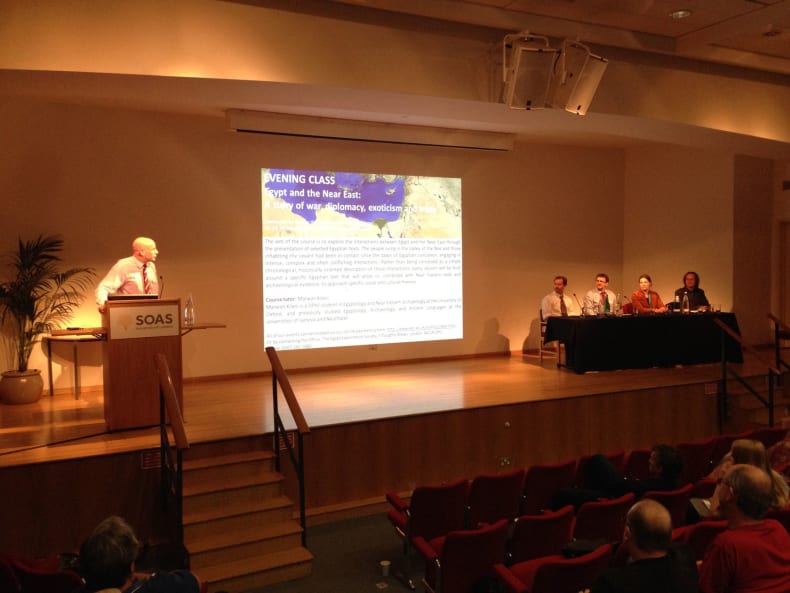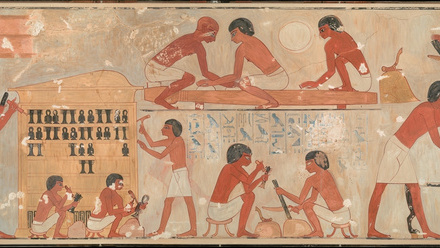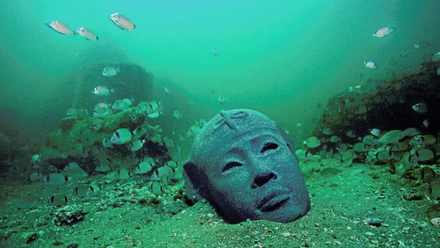Dynasties in disarray! The Second Intermediate Period
After the ground-breaking discoveries at Abydos earlier this year, the Society invited Prof. Josef Wegner (University of Pennsylvania) to present his findings at our London Study Day on 11th October 2014. As well as Prof. Wegner, we were also delighted to host Prof. Kim Ryholt (University of Copenhagen), Dr Irene Forstner-Muller (Austrian Archaeological Institute, Cairo), and Marcel Maree (The British Museum) – all experts in in studies of the Second Intermediate Period. The aim for the day was to present the new findings by Prof. Wegner’s team at Abydos, including the possible new ‘Abydos dynasty’, in the broader political context of the period, including other recent archaeological findings at Tell al-Dab’a and Edfu, as well as textual and artistic research using sources contemporary to the period.
 The speakers, left to right: Prof. Kim Ryholt, Prof. Josef Wegner, Dr Irene Forstner-Muller, Marcel Maree. Thank you to Dyan Hilton for providing these images.
The speakers, left to right: Prof. Kim Ryholt, Prof. Josef Wegner, Dr Irene Forstner-Muller, Marcel Maree. Thank you to Dyan Hilton for providing these images.
Prof. Ryholt kicked off the day with a refreshing introduction to the complex chronology of the period using various textual sources to reconstruct the sequence of regional rulers and dynasties. He introduced the possibility of a royal dynasty existing at Abydos during the Second Intermediate Period using evidence from the Turin King List.
Prof. Wegner enlightened the audience with his new discoveries at Abydos, including the wonderful painted tomb of Seneb-khay, a possible Abydene ruler. The relationship of a series of tombs uncovered around the mortuary complex of Senwosret III was outlined along with their reuse of monuments from a neighbouring tomb of a king Sobekhotep.
Research continues to try and better understand the connections between the Hyksos rulers at Tell el-Dab’a in the eastern Delta and the regional Egyptian rulers in the Nile valley. Dr Forstner-Muller gave a tour of the site of ancient Avaris, including geo-physical surveys that have now revealed the extent of the settlement and its harbours. Sealings found here and at Edfu, naming king Khayan, complicate the regional divisions of Egypt at the time which is further complicated by finds of Assyrian and Nubian sherds across the Delta site.
The Study Day was closed by Marcel Maree, whose work on stelae using art and text highlighted the intricacy of the events title, which could equally have been called, ‘Dynasties in disarray’! Titles, more commonly reserved for royal during the Middle Kingdom, appear on Second Intermediate Period monuments dedicated to local officials. Using patterns of artistic representation and textual formulae it is possible to identify regional workshop production that, when plotted geographically, provide another way of viewing this complicated political period.
 The Society's Chair, Dr Aidan Dodson, takes questions from the audience during the discussion
The Society's Chair, Dr Aidan Dodson, takes questions from the audience during the discussion
It was clear from the event that not all scholars agree that the new discoveries made by Prof. Wegner and his team at Abydos confirm the presence of a local royal dynasty. But it certainly adds greater weight to the need to better understand the Second Intermediate Period and the broader political environment from the 13th Dynasty to the start of the New Kingdom.
 Delegates gather in the Brunei Suite at SOAS after the study day to network...and enjoy the wine! Thank you to Dyan Hilton for providing these images.
Delegates gather in the Brunei Suite at SOAS after the study day to network...and enjoy the wine! Thank you to Dyan Hilton for providing these images.



